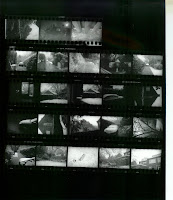Diary Entry
This project went pretty well for me in the darkroom. The times I had to expose the prints were manageable, and I only had one print that was hard to get right immediately. This was the print with my school books. Once I added a high enough filter (5), even that one didn't take me long to finish. I actually had to add a filter to 3 of the 4 claustrophobia prints, and I have become very fond of the filters because of the enormous improvement it made to my photographs.
Theory Notes
I found this project very hard in terms of composing prints that evoked feelings of "claustrophobia". I ended up looking back at old contact sheets to see if I had anything I could use in there. Two of my prints came from the first lighting project, taken in a forest. I used these because I thought the shadows in the forest could make a person claustrophobic. A shadow moves. Was it the wind, or something else? Alone in the woods, someone can start to feel very claustrophobic and panicked.
The other two I took specifically for the profect. For the print with the schoolbooks, I cleared my floor. My floor was very messy (as usual), but I didn't think it would be a good composition for this profect, because usually I feel comfortable in a messy room. After I cleared my floor, I just scattered around schoolwork (which always makes me feel claustrophobic) I think it worked well. Claustrophobia probably isn't the first thing a person would think of when they see the print, but when they know that is the theme, I think it makes sense.
I think it worked well. Claustrophobia probably isn't the first thing a person would think of when they see the print, but when they know that is the theme, I think it makes sense.
My favorite print of the project, though, is the fence. This one I was careful and deliberate about. I shot on a gray day, to give it a gloomy mood. When I took the picture, I shot at an agle, to make the fence appear to go on and on and on. I also shot down the middle, where the wooden fence meets the chained one. I liked this because it supports the idea that no matter what kind of a cage you are in, it's still a cage that you cannot escape. If that's not claustrophobia, I don't know what is!
fence meets the chained one. I liked this because it supports the idea that no matter what kind of a cage you are in, it's still a cage that you cannot escape. If that's not claustrophobia, I don't know what is!
Printing Compositions
First Print: Trees and Road

T 12-18 sec. F 5 A 5.6
 Final Print: A 5.6 F 5 T 15 sec.
Final Print: A 5.6 F 5 T 15 sec.Second Print: Schoolbooks

A 2.8 F 5 T 100-160 sec.

Final Print: A 2.8 F 5 T 140 sec.
Third Print: Fence Line

A 4 T 200-260
Fourth Print: Tall Trees

http://www.teresazafon.com/index.html
 James Nachtwey also taught himself photography. He studied film and political science in university. He was inspired by photographs of the American Civil Rights movement and the Vietnam War. Now, he documents atrocities around the world, especially war. This is a photo of 9/11. I chose this one, even though I like some of the others better, because I remember that day, and how afraid I was. The feeling I remember makes this image the most claustrophobic for me. http://www.jamesnachtwey.com/
James Nachtwey also taught himself photography. He studied film and political science in university. He was inspired by photographs of the American Civil Rights movement and the Vietnam War. Now, he documents atrocities around the world, especially war. This is a photo of 9/11. I chose this one, even though I like some of the others better, because I remember that day, and how afraid I was. The feeling I remember makes this image the most claustrophobic for me. http://www.jamesnachtwey.com/
Amanda Norman gets her obsession with vampires and graveyards from the horror movies she watched growing up. Some of her images are rather disturbing, but most of them capture the creepy atmosphere of a graveyard. I chose this image because it makes me feel claustrophobic (and very mortal) to think that my name could be on that gravestone. It sort of freaks me out.
http://www.amandanorman.com/
P. S. Maybe our next project can be something a little less creepy...































 Trevor Brady is a photographer of fashion and advertising. I chose this image because I wanted to see how a photograph for advertising can be effective. I think the water droplets make the image more effective.
Trevor Brady is a photographer of fashion and advertising. I chose this image because I wanted to see how a photograph for advertising can be effective. I think the water droplets make the image more effective. 


















